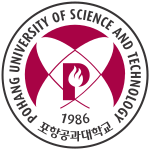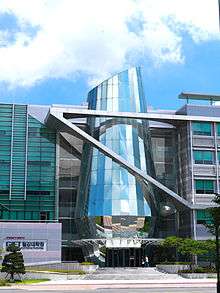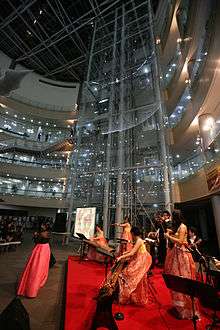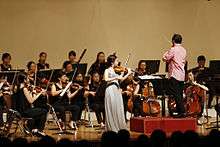Pohang University of Science and Technology
Pohang University of Science and Technology (POSTECH) is a private research university in Pohang, South Korea dedicated to research and education in science and technology.
포항공과대학교 | |
 | |
| Motto | 성실, 창의, 진취 |
|---|---|
Motto in English | Integrity, Creativity, and Aspiration |
| Type | Private |
| Established | 1986 |
| President | Doh-Yeon Kim |
Academic staff | 283 (2018)[1] |
| Students | 3,581 (2018)[1] |
| Undergraduates | 1,422 (2018)[1] |
| Postgraduates | 2,159 (2018)[1] |
| Location | , Gyeongbuk Province , |
| Campus | Urban |
| Mascot | Postech Ponix (Phoenix) |
| Website | postech |
| Pohang University of Science and Technology | |
| Hangul | |
|---|---|
| Hanja | |
| Revised Romanization | Pohang Gonggwa Daehakgyo (or) Poseutek |
| McCune–Reischauer | P'ohang Konggwa Taehakkyo (or) P'osŭt'ek |
In 2012–2014, the Times Higher Education ranked POSTECH 1st in its "100 Under 50 Young Universities" rankings. Since its establishment, POSTECH has been maintaining its prestige and reputation as one of the most prominent young research universities in the world, being 83rd overall in the QS World University Rankings 2019[2] and 12th best in QS Asia University Ranking 2017–2018.[3]
Introduction
History
POSTECH was established in 1986 in Pohang, Korea by POSCO, one of the world's leading steel companies, for the purpose of providing advanced education for budding engineers and laying the groundwork for future technological development.[4]
The founder of POSCO and the founding chairman of POSTECH, Park Tae-joon realized the need for Korea to educate their youth in science and technology to ensure Korea's position in the high technology arena. Park wanted to use the California Institute of Technology (Caltech) as a model for POSTECH and visited the university on a business trip to Los Angeles in 1985. He noted characteristics of Caltech and requested to the POSTECH founding team to establish a contemporary research university that had: a low student-faculty ratio, a greater proportion of graduate students to undergraduates, a low net education cost, student on-campus housing, and a high-quality campus environment. These features represented a drastic departure from the Korean universities of the 1980s.[4]
POSCO organized a task force on February 21, 1984 made up of POSCO employees selected by the company. The American engineering firm, Burns and Roe, had a branch office in Seoul and was asked to help design this new University. Burns and Roe, had an architectural branch office, Roe/Eliseo, in Manhattan. Paul Balev was the architect at Roe/Eliseo who designed the new University now known as POSTECH. Four Korean architectural firms were engaged to develop the design and construction documents with the help of design criteria books produced by Roe/Eliseo. Construction work began on August 17, 1985. On May 4, 1986, British Prime Minister Margaret Thatcher visited POSTECH and donated an Inmos transputer, one of the leading edge computer parts at the time. The first matriculation ceremony was held on March 5, 1987. A group of 249 freshmen were selected from the top one percent of all graduating seniors in Korea to be taught by an international faculty recruited by POSTECH founding president Hogil Kim and POSTECH task force head manager Dai Kong Lee. The first degree awarding ceremony was on February 20, 1991. Diplomas were awarded to 146 graduating seniors, 123 (84%) of whom went on to pursue graduate studies. The remaining 23 graduates were employed by the nation's major corporations including POSCO, Samsung, LG, and Hyundai.[5]
To facilitate translational research and active academia-industry collaboration, POSTECH hosted POSCO's Research Institute of Science and Technology (RIST) on campus. In 1994, POSTECH set up the Pohang Accelerator Laboratory (PAL), a 3rd-generation synchrotron light source and now a national facility. PAL-XFEL, a 4th-generation light source X-ray free electron laser (XFEL) was completed in 2016 at the cost of US$390 million, the third of its kind in the world, and will open up new frontiers and research areas in life sciences, materials, chemistry, and physics.[6]

Timeline

| December 3, 1986 | POSTECH founded by Founding Chairman Tae-joon Park and First President Hogil Kim |
| March 5, 1987 | First matriculation ceremony |
| March 1, 1989 | Department of Life Sciences established |
| February 7, 1990 | First commencement for M.S. candidates |
| February 20, 1991 | Conferment of first B.S. degrees |
| December 7, 1994 | Completion of Pohang Light Source |
| May 15, 1998 | Ranked 1st among Asian science and technology universities by Asiaweek Magazine |
| February 28, 2000 | Pohang Techno Park established jointly with the City of Pohang and POSCO |
| August 23, 2001 | Asia Pacific Center for Theoretical Physics relocates to POSTECH |
| August 17, 2002 | Selected as an "Excellent University for Educational Reform" for the seventh consecutive year by the Ministry of Education and Human Resources Development |
| April 25, 2003 | Tae-joon Park Digital Library opens |
| September 9, 2005 | Graduate Institute of Ferrous Technology (GIFT) established |
| May 30, 2007 | National Institute for Nanomaterials Technology established |
| March 2, 2010 | Bilingual campus declared |
| June 14, 2010 | Agreement with Max Planck Society to establish Max Planck POSTECH/Korea Research Initiative |
| September 16, 2010 | Ranked 28th in the World University Rankings by Times Higher Education |
| July 6, 2011 | Department of Creative IT Engineering established |
| August 20, 2012 | Graduate School of Engineering Mastership established |
| December 1, 2012 | Selected as one of the 2012 Top 100 Global Innovators by Thomson Reuters |
| February 15, 2013 | Tae-joon Park Institute opened |
| May 9, 2013 | Groundbreaking of PAL-XFEL |
| June 13, 2013 | Four research centers of Institute for Basic Science established |
| June 20, 2013 | Ranked 1st among the top 100 universities under 50 years old by Times Higher Education |
| October 7, 2013 | Ranked 1st in Joong Ang Ilbo Korean University Rankings 2013 |
| May 2, 2014 | Ranked 1st among the top 100 universities under 50 years old by Times Higher Education (three consecutive years) |
| September 15, 2014 | POSTECH Entrepreneurship Center opened (supported by Small & Medium Business Administration) |
| September 19, 2014 | APGC-Lab and a new start-up company (exBrain) opened |
| October 6, 2014 | Ranked 1st in Joongang Ilbo Korean University Rankings (two consecutive years) |
| December 17, 2014 | The Pohang Center for Creative Economy & Innovation opened (5th floor of C5) |
| June 4, 2016 | PAL-XFEL achieved first light |
Presidents
| Number | Name | Years in office |
|---|---|---|
| 1 | Hogil Kim | 1985-1994 |
| 2 | Sooyoung Chang | 1994-1998 |
| 3 | Sungkee Chang | 1998-2002 |
| 4 | Chanmo Park | 2003-2007 |
| 5 | Sunggi Baik | 2007-2011 |
| 6 | Yongmin Kim | 2011–2015 |
| 7 | Doh-Yeon Kim | 2015–2019 |
| 8 | Moo Hwan Kim | 2019–Present |
University rankings
| QS National[7] | General | 6 |
|---|---|---|
| ARWU National[8] | General | 9-10 |
| USNWR National[9] | General | 6 |
| QS Asia (Asian Ranking version)[10] | General | 24 |
| THE Asia[11] | General | 16 |
| USNWR Asia[12] | General | 40 |
| THE World[13] | General | 146 |
| QS World[14] | General | 87 |
| USNWR World[15] | General | 322 |
| ARWU World[16] | Research | 401-500 |
| THE World (Young)[17] | General/Young | 8 |
| QS World (50 Under 50)[18] | General/Young | 7 |
In 1998, POSTECH was ranked by Asiaweek as the best science and technology university in Asia.[19] From 2002 to 2006, one of Korea's most circulated daily newspapers, JoongAng Ilbo, ranked POSTECH as the leading university in Korea. In 2010, the Times Higher Education ranked POSTECH 28th in the world.[20] In 2011, the Times Higher Education[21] ranked the university as the 53rd best university in the world, the 6th best in Asia, and the best in South Korea. In 2017–2018, QS World University Rankings ranked POSTECH 71st overall in the world. It remains third best ranked in Korea, after Seoul National University and KAIST, in the QS Asian University Rankings.[22] However, in the Times Higher Education rankings, it scored highly after compilers placed less emphasis on "reputation and heritage" and gave more weight to objective measures including the influence of universities' research, placing 53rd.[23] In 2012 and 2013, the Times Higher Education ranked POSTECH 1st in its "100 Under 50 Young Universities" rankings.[24] The New York Times[25] and the International Herald Tribune[26] cited POSTECH's rapid ascent as a young university to top the world rankings in less than 50 years.
Campus
POSTECH is a 400-acre campus located twenty minutes by car from downtown Pohang, an hour by bus from Busan, and approximately two and half hours by train (KTX) from Seoul.

Tae-Joon Park Digital Library
Completed in 2003, the Tae-Joon Park Library is 24,420 square meters with 352,977 volumes and 8,324 digital and paper journals. As of 2005, the library collection consists of approximately 320,000 books, 3,500 journals, 7,000 e-journals 25 databases, and 4,400 multimedia materials. The Library shares materials with industrial-educational-research cooperation and is part of an intercollegiate data exchange program with approximately 150 other research and educational institutions throughout the nation.[27]
Smart campus
POSTECH operates a Smart Campus where the scientific and technological information of the world is accessible anywhere on campus using different types of smart phones and mobile devices as well as laptops. In 2010, for the first time among Korean universities, POSTECH implemented a Desktop Cloud Service, providing a convenient and secure computing environment. However, as of 2018, many of the previously implemented technological services (e.g. campus smartphone applications, university website, university online portal, etc.) are defective as they have not been since updated, and are only accessible through Internet Explorer. [28]
On-campus dormitories and family housing
POSTECH offers students living on-campus in affordable dormitories and apartments for married graduate students. The student housing complex is composed of 23 five-story student dormitories, one 13-story undergraduate student dormitory, and 4 graduate student apartments. All POSTECH undergraduate students are required to live in one of the on-campus dormitories and many graduate students prefer to stay on campus, either in the student dormitories or in one of the four high-rise graduate student apartments.
Gymnasium and sports complex
POSTECH has a range of sports facilities, from a gymnasium equipped with racquetball, basketball and badminton courts to POSPLEX, a sports center with a swimming pool, a fitness center and an indoor golf driving range, and outdoor sports fields for tennis, futsal, and soccer.
"First bilingual campus in Korea"
In March 2010, POSTECH declared the initiation of a bilingual campus. However, as of 2018, the vast majority of notices and announcements are made only in Korean. Most major official events (e.g., commencement) are also only run in Korean. While course catalogs list courses as taught in English, many professors decide to teach in Korean because international members represent only a minority of the classroom. The rising consensus from international students reveals the difficulty of living and studying as a non-Korean speaker at POSTECH.
Academics
Admissions
POSTECH admits approximately 300 undergraduate students each year. POSTECH received 1,987 applicants for freshman admission and admitted 323 for the 2014 school year. POSTECH provides the highest educational investment and the most per-student scholarship support in Korea, allowing students from all economic backgrounds the opportunity to obtain a POSTECH education.[29]
Graduate admissions
A growing number of international students attend POSTECH as it expands its recruiting efforts abroad. POSTECH offers full tuition fellowships to excellent graduate students from the following countries: Afghanistan, Bhutan, Cambodia, China, Democratic Republic of the Congo, India, Indonesia, Japan, Kazakhstan, Malaysia, Mongolia, Pakistan, Philippines, Singapore, Taiwan, Tajikistan, Thailand, Uzbekistan, Vietnam, and Zimbabwe. However, the international program still lacks proper care and attention to the well-being and integration of international students into POSTECH, as the university's cultural and social norms are not suited for an international community. Growing reports indicate the wide spread presence of racism, sexism, and discrimination against international students.
All graduate students receive a small teaching assistant scholarships and the university provides the Tae-Joon Park Graduate Fellowship, which provides the highest level of scholarship (approximately 25 million South Korean won) to about 50 top graduate students each year. The POSCO Fellowship is available for students recommended by a POSTECH departmental committee and then selected by the POSCO TJ Park Foundation.[30] POSTECH offers a one-time settlement grant of approximately US$1,500 to all incoming international graduate students during the first semester of enrollment. As of 2018, graduate students will receive a sum balance of approximately $153 per month from the teaching assistant scholarship to pay for food and living expenses.
Graduate students have the option of enrolling in the MS-Ph.D. integrated program. Under this program, students can work towards a Ph.D. degree after passing the Ph.D. qualifying exam without going through the MS program. Ph.D. applicants must have earned a master's degree before enrolling at POSTECH.
Undergraduate education
The undergraduate research program provides students with opportunities to participate in research under the guidance and mentorship of professors. Scholarships are offered to encourage student participation in research. In several departments such as Chemistry and Mathematics, it is mandatory for all students to participate in the undergraduate research program.
Courses and activities on entrepreneurship are available, and efforts to strengthen the entrepreneurial spirit and start-up support are being developed including club activities, start-up prep group, training on patents, and leave of absence for creating a new venture.
Through the Science & Technology Core (STC), courses that extend beyond departmental boundaries, students are allowed to take classes in different departments for an interdisciplinary and broad academic foundation.
POSTECH operates the Residential College program for all freshmen and sophomores. Opportunities for personal development, social and cultural experiences, extracurricular group activities, and volunteer opportunities are occasionally available for students to participate in and enhance their undergraduate experience.
Cultural programs

POSTECH's partnership with Korea National University of Arts allows students to take courses on both campuses and organize performances.
Departments
Undergraduate departments
11 undergraduate departments:
- Department of Mathematics
- Department of Physics
- Department of Chemistry
- Department of Life Sciences
- Department of Materials Science & Engineering
- Department of Mechanical Engineering
- Department of Industrial & Management Engineering
- Department of Electrical Engineering
- Department of Computer Science & Engineering
- Department of Chemical Engineering
- Department of Creative IT Engineering (CiTE)
- Division of Humanities & Social Sciences
Graduate departments
11 graduate departments, 4 divisions, 5 graduate schools, and 4 specialized graduate schools:
- Department of Mathematics
- Department of Physics
- Department of Chemistry
- Department of Life Sciences
- Department of Materials Science & Engineering
- Department of Mechanical Engineering
- Department of Industrial & Management Engineering
- Department of Electrical Engineering
- Department of Computer Science & Engineering
- Department of Chemical Engineering
- Department of Creative IT Engineering (CiTE)
- Division of Advanced Materials Science
- Division of Integrative Biosciences & Biotechnology(IBB)
- Division of IT Convergence Engineering
- Division of Advanced Nuclear Engineering
- School of Environmental Science & Engineering (SEE)
- School of Interdisciplinary Bioscience & Bioengineering (I-BIO)
- Graduate Program for Technology & Innovation Management (TIM)
- Graduate School of Wind Energy
- Graduate School of Engineering Mastership (GEM)
- Graduate Institute of Ferrous Technology (GIFT)
- Ocean Science and Technology Institute (POSTI)
- Graduate School of Engineering Mastership (GEM)
- Graduate School for Information Technology (GSIT)
Research
Research institutes and infrastructure
4th generation light source
The 4th generation light source (PAL-XFEL), which has been operational since 2015, is 10 billion times brighter than the 3rd generation light source. PAL-XFEL will generate new knowledge and discoveries in almost all technical and scientific disciplines including medicine, pharmaceutics, chemistry, material science, nanotechnology, power engineering and electronics.[31]
Asia Pacific Center for Theoretical Physics
Asia Pacific Center for Theoretical Physics (APCTP) is theoretical physics research group with international joint research programs in the Asia-Pacific region. The APCTP was founded in June 1996 as an international non-governmental organizations, with 16 current member states. it is a close-knit, multi-disciplinary research environment that hosts scientists working on challenging problems at the forefront of biophysics, condensed matter, quantum information, astrophysics, cosmology and particle physics. The institute also plays a key role in Korea by inviting international scholars, acting as a conduit for collaboration through focus workshops and training young scientists. The center was founded in 1996 by Nobel Laureate Chen-Ning Yang.
C5 (Creative・Collaborative・Cultivating・Convergence・Center)
C5 plays a pivotal role in catalyzing world-first convergence education and research, and fostering future global leaders with a creative and challenging spirit. C5 was named after Creative, Collaborative, Cultivating, Convergence, and Center. C5 has 7-stories with a size of 16,000 square meters per floor. The construction of C5 came at an investment of 31.5 billion won. Construction began in October 2013 and its inauguration ceremony was held on January 30, 2015.
The first three floors of C5 is filled by the Department of Creative IT Engineering (CiTE) and the POSTECH Future IT Innovation Laboratory (i-Lab). CiTE and i-Lab use interdisciplinary-oriented education and innovative research. The remaining three floors house POSTECH research teams that work for POSTECH's strategic promotion of research areas and subjects with huge growth potential. A modern open-space design allows various research teams to rearrange work areas freely to facilitate and promote dynamic collaboration.
The POSCO Pohang Center for Creative Economy occupies the 5th floor of C5. The Center, led by POSCO, was established to maintain the competitiveness of the steel industry, promote source technology development, and nurture regionally-based "hidden champions" to vitalize venture businesses.
Institute for Basic Science
The Institute for Basic Science (IBS) is operating four basic science research centers at POSTECH in the fields of life sciences (Academy of Immunology and Microbiology - Charles Surh), mathematics (Center for Geometry and Physics - Oh Yong-Geun), chemistry (Center for Self-assembly and Complexity - Kim Kimoon), and physics (Center for Artificial Low Dimensional Electronic Systems - Yeom Han-woong). Academy of Immunology and Microbiology officially closed on Oct 15, 2019.
Max Planck POSTECH/Korea Research Initiative
The Max Planck Society of Germany and POSTECH established two Max Planck Centers at POSTECH: the Max Planck-POSTECH Center for Attosecond Science and the Max Planck-POSTECH Center for Complex Phase Materials. This collaboration is not only a testament to POSTECH's research excellence, and with the introduction of advanced research institute operation and management methods, also lays a foundation for further strengthening Korea's competitiveness in basic science research.
National Institute for Nanomaterials Technology
The National Institute for Nanomaterials Technology, a core research center for advancement and commercialization of nanotechnology, is developing the next-generation semiconductor and display materials, etc. The Institute provides technical support and assistance to industry, from research and development to commercialization. The Institute also supports and enables POSTECH researchers to actively carry out nanotechnology and other related areas.
POSTECH Biotech Center
The POSTECH Biotech Center was founded in 2000 with the goal of becoming the hub of biotechnology research and business development (R&BD). The primary goal of the POSTECH Biotech Center is to incubate disruptive technologies in biotechnology areas for the development of immunology, pharmaceuticals, and nanobiotechnology. The Center has been participating actively in academia-industry collaboration both nationally and internationally.
Pohang Light Source (PLS-II)
The 3rd generation light source at POSTECH is the 5th in the world and the only synchrotron radiation accelerator in Korea. This national research facility enables studies on various structural characteristics of materials using light. The facility is utilized in various basic science to high-tech industrial research. Its performance improvement to PLS-II was successfully completed in 2012. Thousands of users visit yearly to conduct their research using PLS-ll.
Distinguished Faculties and Alumni
- Sir Harshad Kumar Dharamshi Hansraj Bhadeshia: A distinguished materials scientist and professor at Graduate Institute of Ferrous Technology
- Frédéric Barlat: One of the leading scientists in the field of plasticity and continuum mechanics.
Student life
Sunrise Festival
Since 1987, POSTECH has hosted the annual Sunrise Festival to celebrate the spirit of unity and harmony of the POSTECH members and the local community. It is run in mid-May for three days immediately after the midterm of the spring semester. This festival is financially supported by the university, and is prepared by the entire student body and the POSTECH Student Club Association. Participants at the festival can enjoy movies, performances, singing contests, quiz shows, as well as traditional Korean drinks sold at cafes, beer gardens, and food stalls set up by student clubs.
POSTECH-KAIST Science War
Science War is an event held together by KAIST and Pohang University of Science and Technology every year in the fall. The first tournament was held in 2002 at KAIST. Every year since, both schools held it alternately. The competition name is determined depending by the home university. If held at KAIST, it is called "Pocajeon"; at the Pohang University of Science and Technology, it is called "Kapojeon". Events include football, baseball, basketball, athletics and hacking competitions, League of Legend, and a science quiz.
Hyungsan Academic Festival
The Hyungsan Academic Festival, organized by the Federation of Student Circles, takes place at the end of October after the midterm of the second semester. Originally designed to provide venues for academic presentations by students' circles and departments, this festival now provides various programs including sports competition, plays and movie festivals, as well as academic conferences.
Annual budget (FY 2015)
Revenue (total: US$277.5M, US$1=KRW1,105)
- Research grants and contracts: $141.9M (51.1%)
- Endowment income: $54.1M (19.5%)
- Tuitions: $22.7M (8.2%)
- Gifts and special grants: $14.9M (5.4%)
- Others: $43.9M (15.8%)
Expenses (total: US$277.5M, US$1=KRW1,105)
- Research expenses: $137.3M (49.4%)
- Salaries and wages: $50.7M (18.3%)
- Fixed asset costs: $15.0M (5.4%)
- Operation and maintenance: $23.4M (8.4%)
- Student aids and services: $17.9M (6.5%)
- Others: $33.2M (12.0%)
References
- "About POSTECH". POSTECH Official website. POSTECH. Retrieved 12 December 2018.
- "QS World University Rankings 2019". February 2017.
- "QS University Rankings: Asia 2018". February 2017.
- "The Road to Academic Excellence: The Making of World-Class Research Universities". The World Bank September 2011. Retrieved April 17, 2014.
- Cho, Seihon (2006). Self-portrait of Postechians. Pohang: POSTECH Audio-Visual Office.
- Seo, Ji-eun (30 September 2016). "Korea builds advanced particle accelerator". Korea Joongang Daily. Retrieved 19 May 2020.
- "QS South Korea University Rankings 2019". Top Universities. 2019. Retrieved July 20, 2019.
- World University Rankings - 2019 (2019). "South Korea Universities in Top 500 universities". Academic Ranking of World Universities. Retrieved August 16, 2019.
- U.S.News & World Report (2019). "Search Best Global Universities - US News Education". U.S. News & World Report LP. Retrieved July 20, 2019.
- "QS Asian University Rankings". QS Quacquarelli Symonds Limited. 2019. Retrieved August 16, 2019.
- "Times Higher Education Asia University Rankings". Times Higher Education. 2019. Retrieved August 16, 2019.
- U.S.News & World Report (2019). "Best Global Universities in Asia - US News Education". U.S. News & World Report LP. Retrieved July 20, 2019.
- "THE World University Rankings". Times Higher Education. 2020. Retrieved October 19, 2019.
- "QS World University Rankings". QS Quacquarelli Symonds Limited. 2020. Retrieved August 16, 2019.
- U.S.News & World Report (2019). "Best Global Universities - US News". U.S. News & World Report LP. Retrieved July 20, 2019.
- "Academic Ranking of World Universities". Institute of Higher Education, Shanghai Jiao Tong University. 2019. Retrieved August 16, 2019.
- "Young University Rankings 2019". Times Higher Education (THE). 2019. Retrieved July 21, 2019.
- "QS Top 50 Under 50 2020". QS Quacquarelli Symonds Limited. 2020. Retrieved July 21, 2019.
- "Ahead of the curve: Asia's science and technology institutes mix students and success". Asiaweek May 15, 1998. Retrieved July 6, 2005.
- "Times Higher Education's World University Rankings 2010-2011". 2015-04-13.
- "Times Higher Education's 2011-2012 World University Rankings".
- "QS Asian University Rankings: Overall in 2012". Quacquarelli Symonds. 2012. Retrieved 2012-07-06.
- "Times Higher Education world top 200 universities".
- "Times Higher Education's 100 Under 50 Universities 2013". 2015-04-13.
- Lau, Joyce (2012-06-04). "Who's the Next M.I.T.?". New York Times June 4, 2012. Retrieved April 11, 2014.
- Yang, Calvin (2013-06-24). "Korean Institute Tops List of Younger Universities". IHT June 25, 2013. Retrieved April 11, 2014.
- "Introduction". Tae-Joon Park Digital Library. 2005. Archived from the original on February 27, 2014. Retrieved April 17, 2014.
- "Smart Campus". POSTECH Website. Retrieved October 1, 2013.
- "POSTECH Spent Most Money on Students". The Chosun Ilbo September 23, 2008. Retrieved September 30, 2013.
- "POSTECH Graduate Admissions Costs and Financial Aid". Retrieved April 17, 2014.
- Seo, Ji-eun (30 September 2016). "Korea builds advanced particle accelerator". Korea Joongang Daily. Retrieved 31 January 2019.
External links
| Wikimedia Commons has media related to Pohang University of Science and Technology. |